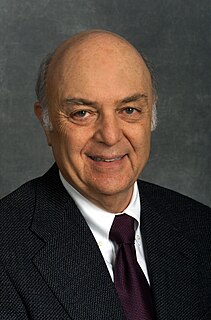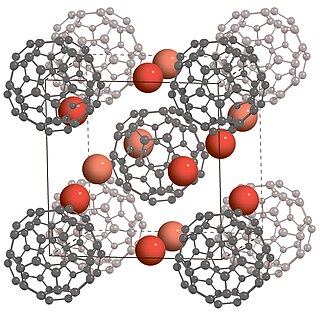Related Research Articles

John Robert Schrieffer was an American physicist who, with John Bardeen and Leon Cooper, was a recipient of the 1972 Nobel Prize in Physics for developing the BCS theory, the first successful quantum theory of superconductivity.
Malcolm Roy Beasley is an American physicist. He is Professor Emeritus of Applied Physics at Stanford University. He is known for his research related to superconductivity.
A two-dimensional electron gas (2DEG) is a scientific model in solid-state physics. It is an electron gas that is free to move in two dimensions, but tightly confined in the third. This tight confinement leads to quantized energy levels for motion in the third direction, which can then be ignored for most problems. Thus the electrons appear to be a 2D sheet embedded in a 3D world. The analogous construct of holes is called a two-dimensional hole gas (2DHG), and such systems have many useful and interesting properties.

Marvin Lou Cohen is an American theoretical physicist. He is a University Professor of Physics at the University of California, Berkeley. Cohen is a leading expert in the field of Condensed Matter Physics. He is highly cited and most widely known for his seminal work on the electronic structure of solids.
Gregory Scott Boebinger is the director of the National High Magnetic Field Laboratory in Tallahassee, Florida, and a professor of physics at Florida State University.

Proximity effect or Holm–Meissner effect is a term used in the field of superconductivity to describe phenomena that occur when a superconductor (S) is placed in contact with a "normal" (N) non-superconductor. Typically the critical temperature of the superconductor is suppressed and signs of weak superconductivity are observed in the normal material over mesoscopic distances. The proximity effect is known since the pioneering work by R. Holm and W. Meissner. They have observed zero resistance in SNS pressed contacts, in which two superconducting metals are separated by a thin film of a non-superconducting metal. The discovery of the supercurrent in SNS contacts is sometimes mistakenly attributed to Brian Josephson's 1962 work, yet the effect was known long before his publication and was understood as the proximity effect.
Chih-Tang "Tom" Sah is a Chinese-American electronics engineer and condensed matter physicist. He is best known for inventing CMOS logic with Frank Wanlass at Fairchild Semiconductor in 1963. CMOS is now used in nearly all modern very large-scale integration (VLSI) semiconductor devices.
William Martin Fairbank was an American physicist known in particular for his work on liquid helium.

Steven Allan Kivelson is an American theoretical physicist known for several major contributions to condensed matter physics. He is currently the Prabhu Goel Family Professor at Stanford University. Before joining Stanford in 2004, he was a professor of physics at the University of California at Los Angeles. He is a son of Margaret Kivelson, and his father, Daniel Kivelson, was a professor of chemistry in UCLA.

Fullerides are chemical compounds containing fullerene anions. Common fullerides are derivatives of the most common fullerenes, i.e. C60 and C70. The scope of the area is large because multiple charges are possible, i.e., [C60]n− (n = 1, 2...6), and all fullerenes can be converted to fullerides. The suffix "-ide" implies their negatively charged nature.
Nadya Mason is the Rosalyn Sussman Yalow Professor of Physics at the University of Illinois at Urbana-Champaign. As a condensed matter experimentalist, she works on the quantum limits of low-dimensional systems. Mason is the Director of the Illinois Materials Research Science and Engineering Center (I-MRSEC) and, since September 1 of 2022, the Director of the Beckman Institute for Advanced Science and Technology. She is the first woman and woman of color to work as the director at the institute. In 2021, she was elected to the National Academy of Sciences.

Contorted aromatics or more precisely contorted polycyclic aromatic hydrocarbons are polycyclic aromatic hydrocarbons (PAHs) in which the fused aromatic molecules deviate from the usual planarity.

Jagdish Narayan is an Indian-born American engineer. Since 2001, he has served as the John C. C. Fan Family Distinguished Chair Professor in the Materials Science and Engineering Department at North Carolina State University. He is also the distinguished visiting scientist at Oak Ridge National Laboratory. Narayan has published above 500 high-impact journal articles, with his discoveries covered in over 40 US and international patents. His body of work can be segregated into highly nonequilibrium laser processing of novel nanomaterials, including Q-carbon, Q-BN, diamond and c-BN related materials. These research articles have received over 31,000 Google Citations with h-index >85. Narayan and his students discovered Q-carbon as the new allotrope, thereby finding a new route to fabricate diamond and related materials in ambient conditions, resulting in properties and applications ranging from high-temperature superconductivity in boron-doped Q-carbon to hardness than diamond in Q-carbon to enhanced field-emission in Q-carbon to nitrogen-doped nanodiamonds for quantum computing, nanosensing and solid-state devices.
Tony Frederick Heinz is an American physicist.
Sefaattin Tongay is an American materials scientist and engineer internationally recognized for materials synthesis and discovery for next-generation quantum technologies. He is the chair of undergraduate Materials Science and Engineering at Arizona State University and serves as an associate editor at American Institute of Physics (AIP) Applied Physics Reviews and Nature 2D materials & applications by Nature.
Yvan J. Bruynseraede is a condensed matter experimental physicist, known for his work on multilayers and superlattices, and his interests are thin films, nanostructures, novel materials, magnetism, and superconductivity. He is currently Professor Emeritus at the Catholic University of Leuven (KULeuven), and a member of the Quantum Solid-State Physics Laboratory.
Bogdan Andrei Bernevig is a Romanian Quantum Condensed Matter Professor of Physics at Princeton University and the recipient of the John Simon Guggenheim Fellowship in 2017.

Simon John Bending, is a British physicist. He is a professor in the Department of Physics at the University of Bath, where he was the Head of department from 2013 to 2016. He is co-director of the Bath-Exeter Centre for Graphene Science and deputy director of the Bath-Bristol EPRSC Centre for Doctoral Training in Condensed Matter Physics. He developed scanning Hall probe microscopy and has made notable contributions to the field of superconductors.
Aron Pinczuk was an Argentine-American experimental condensed matter physicist who was professor of physics and professor of applied physics at Columbia University. He was known for his work on correlated electronic states in two dimensional systems using photoluminescence and resonant inelastic light scattering methods. He was a fellow of the American Physical Society, the American Association for the Advancement of Science and the American Academy of Arts and Sciences.
Allen Marshall Goldman is an American experimental condensed matter physicist, known for his research on electronic transport properties of superconductors and for the eponymous Carlson-Goldman mode involving collective oscillations in superconductors.
References
- ↑ "Science: Soccer-ball-shaped molecule becomes a superconductor".
- ↑ Hebard, A. F.; Rosseinsky, M. J.; Haddon, R. C.; Murphy, D. W.; Glarum, S. H.; Palstra, T. T. M.; Ramirez, A. P.; Kortan, A. R. (1991). "Superconductivity at 18 K in potassium-doped C60". Nature . 350 (6319): 600. Bibcode:1991Natur.350..600H. doi:10.1038/350600a0. hdl: 11370/3709b8a7-6fc1-4b32-8842-ce9b5355b5e4 .
- ↑ Search for fractional charge using low temperature techniques; Thesis (Ph.D), 1971, search works.stanford.edu
- ↑ "2018 Stanley Corrsin Award Recipient".
- ↑ "2018 Stanley Corrsin Award Recipient".
- ↑ Arthur Hebard at the University of Florida
- ↑ "University of Florida physicists set new record for graphene solar cell efficiency".